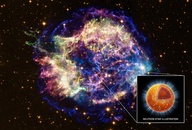- 3530 - CASSIOPEIA - nebula of an exploding star? The original star was part of a binary star system, where two stars orbit each other. This companion star also could have gone supernova before Cassiopeia A and blasted off the star's hydrogen "skin" in the process.
--------------------- 3530 - CASSIOPEIA - nebula of an exploding star?
- A powerful shock wave traveling through Cassiopeia’s cloud of gas left behind by the explosive death of a star has a bizarre quirk: Part of it is traveling in the wrong direction.
-
- Researchers found that the shock wave is accelerating at different rates, with one section collapsing back toward the origin of the stellar explosion, or supernova, a "reverse shock."
-
- Cassiopeia A is a nebula, or gas cloud, left behind by a supernova in the constellation Cassiopeia, around 11,000 light-years from Earth, making it one of the closest supernova remnants.
-
- The nebula, which is around 16 light-years wide, is made of gas, mainly hydrogen, that was expelled both before and during the explosion that ripped apart the original star. A shock wave from that explosion is still rippling through the gas, and theoretical models show that this shock wave should be expanding evenly, like a perfectly rounded balloon that's constantly being inflated.
-
- But the researchers found that this wasn't the case. Previous studies had shown that the internal motions within the nebula were "rather chaotic" and highlighted that the western region of the shock wave moving through the gas cloud might even be going in the wrong direction.
-
- The researchers analyzed the movement of the shock wave, using X-ray images collected by NASA's Chandra X-ray Observatory, a telescope that orbits Earth. The data, collected over 19 years, confirmed that part of the western region of the shock wave was, in fact, retreating in the opposite direction in a reverse shock.
-
- They also discovered something even more surprising: Parts of the same region were still accelerating away from the supernova's epicenter, like the rest of the shock wave.
-
- The current average speed of the expanding gas in Cassiopeia A is around 13,400,000 miles per hour, which makes it one of the fastest shock waves ever seen in a supernova remnant. This is mainly because the remnant is so young; light from Cassiopeia A reached Earth in 1970. Over time, shock waves lose their momentum to their surroundings and slow down.
-
- Cassiopeia A consists of two main expanding bands of gas: an inner shell and an outer shell. These two shells are two halves of the same shock wave, and across most of the nebula, the inner and outer shells are traveling at the same speed and in the same direction.
-
- But in the western region, the two shells are going in opposite directions: The outer shell is still expanding outward, but the inner shell is moving back toward where the exploding star would have been.
-
- The reverse shock is retreating at around 4,300,000 mph , which is about a third of the average expansion speed of the rest of the nebula. However, what really puzzled the researchers was how fast the outer shell was expanding compared with the retreating inner shell in this region.
-
- The researchers had expected the outer shell to be expanding at a decreased rate compared with the rest of the shock wave, but they found that it was actually accelerating faster than some other regions of the shock wave.
-
- The unusual expansion within Cassiopeia A's western region does not match up with theoretical supernova models and suggests that something happened to the shock wave in the aftermath of the stellar explosion.
-
- The most likely explanation is that the shock wave collided with another shell of gas that was likely ejected by the star before it exploded. As the shock wave hit this gas, it may have slowed down and created a pressure buildup that pushed the inner shell back toward the center.
-
- However, the outer shell still may have been forced through this blockage and begun to accelerate again on the other side. This explains both the inward movement of the inner shell but also predicts that the outer shell should be accelerating.
-
- The researchers also think the unique way the original star died could explain the uneven shock wave. Cassiopeia A is the result of a Type IIb supernova, in which a massive star exploded after it had almost completely shed its outer layers.
-
- X-ray estimates suggest that the star was around four to six times the mass of the sun during the explosion, but the star most likely had a mass of around 18 times the sun when it was born. This means the star lost around two-thirds of its mass, most of which would have been hydrogen, before it exploded; The shock wave may have later collided with this gas.
-
- There are several theories as to why Cassiopeia A lost so much of its mass before it exploded. In September 2020, researchers proposed that the original star was part of a binary star system, where two stars orbit each other. This companion star also could have gone supernova before Cassiopeia A and blasted off the star's hydrogen "skin" in the process.
-
- Leaving much more for astronomers to explore. It is a new world our there!
-
April 1, 2022 CASSIOPEIA - nebula of an exploding star? 3530
----------------------------------------------------------------------------------------
----- Comments appreciated and Pass it on to whomever is interested. ---
--- Some reviews are at: -------------- http://jdetrick.blogspot.com -----
-- email feedback, corrections, request for copies or Index of all reviews
--- to: ------ jamesdetrick@comcast.net ------ “Jim Detrick” -----------
--------------------- --- Saturday, April 2, 2022 ---------------------------

No comments:
Post a Comment